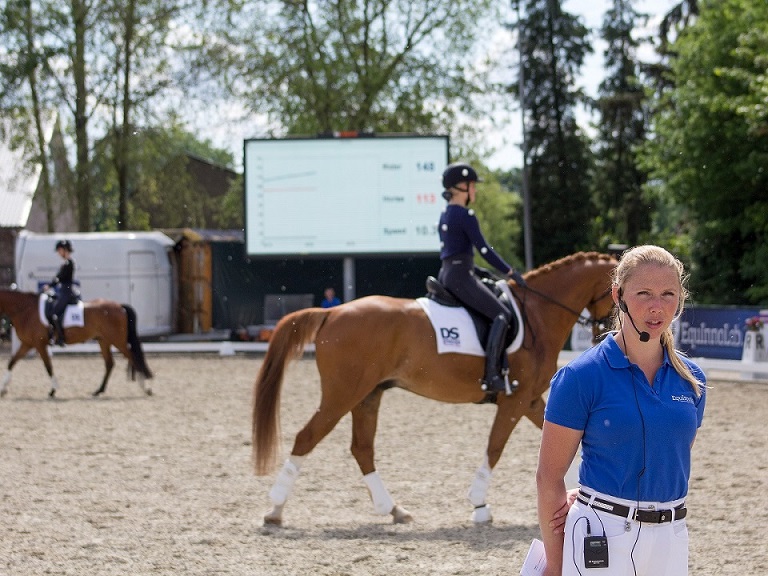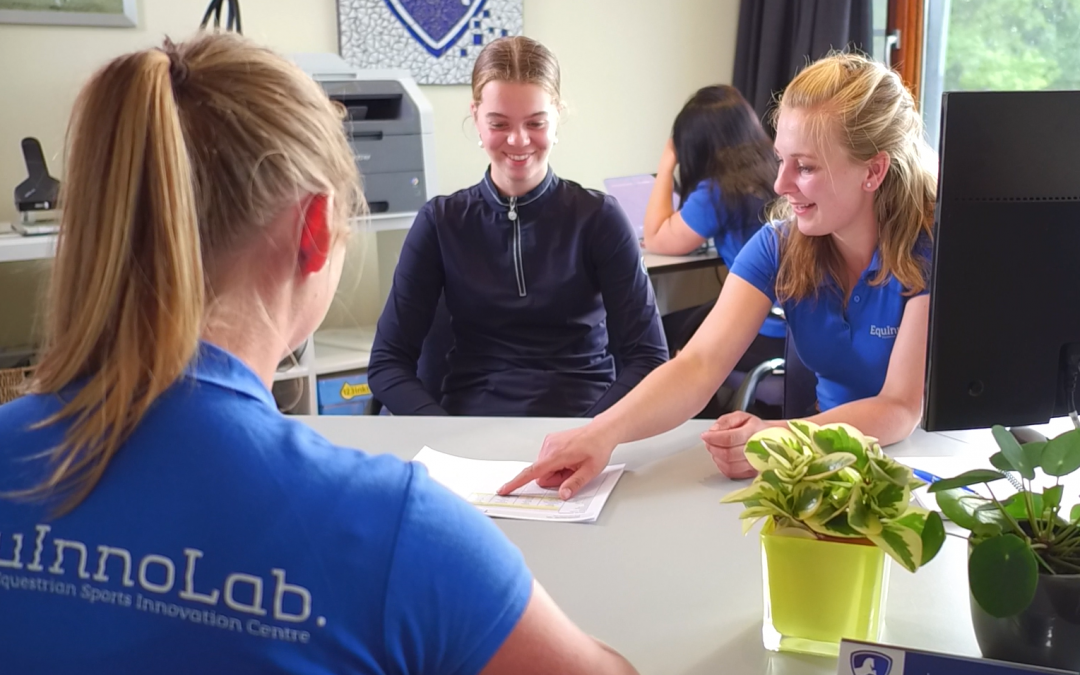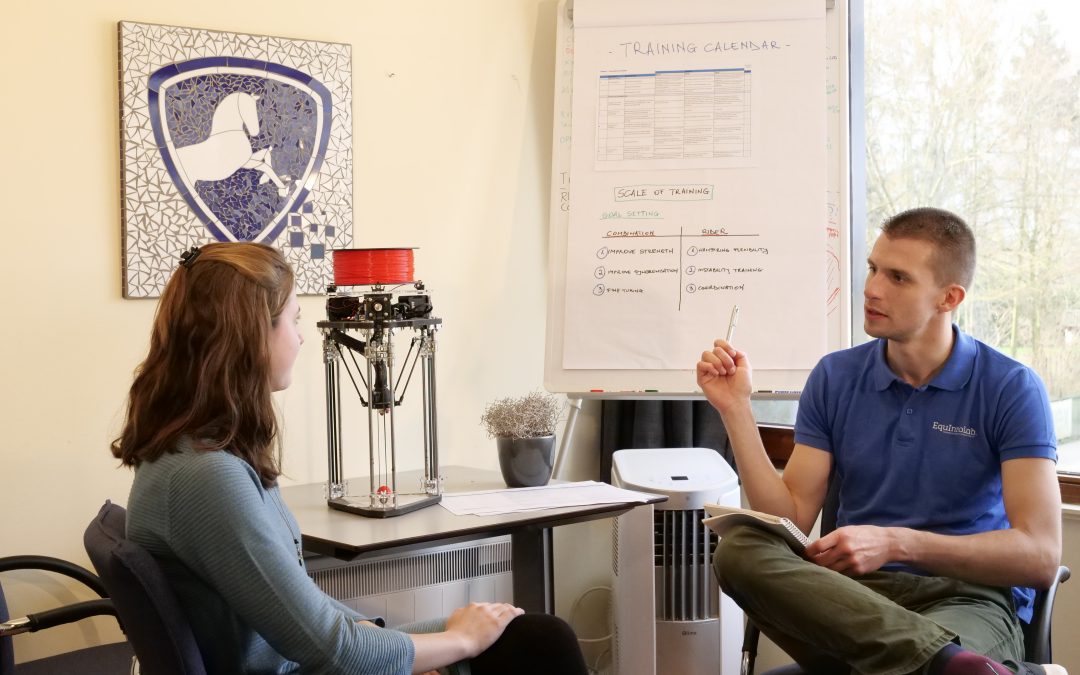We all know that a training can feel intense, average, or easy. But do you also know that more in-depth knowledge about the intensity, and what each intensity is good for, makes us better athletes?
With the right training we can improve performances and the fitness of our horse and ourselves. In order to improve the fitness there are some fundamental principles. First we need to expose the body to a stimulating training load. A stimulating training load is a certain exercise or movement that is just a bit harder than the body is used to. This is a so called overload training. Second, the body needs to recover from the physical stress it suffered from the overload training. Finally, the body is recovered and stronger or fitter than before.
This principle is relatively easy and understandable. However to apply the right amount of training load at the right time in your training program is more challenging. If done properly you and your horse will improve efficiently with a lower risk of injuries. If not done properly, improvement can hold off an you can risk a higher chance on injuries. A good application of a training load can be the difference between excelling or dropping out.
Training load variations: overreaching, supercompensation and overtraining
To improve the fitness we need a stimulating training load. We use variations in training load in order to stimulate the body to keep improving. With a constant new and varied training load and time to recover the body will keep improving in fitness. If we do not use a variation in training load the improvement of fitness will reach a plateau and is no longer improving. With an excessive training load where the body has no time to adapt performance will decrease .Variations in training load are done with a higher frequency, higher duration or higher intensity than a normal training. To avoid an overtraining only one of these three types of variations is changed in one training.
The process of improving the body by exposing it to a higher training load is called a progressive overload. Without a progressive overload there is no improvement in fitness. The basis of progressive overload is supercompensation. The theory of supercompensation suggest that for the best training adaptions to occur, training intensities, training volumes and bioenergetic specificity have to be systematically and rationally alternated in a sequence of phases. These phases need to have an addition of recovery time. Supercompensation is a relationship between work and regeneration that leads to superior physical adaptations.
The body suffers from physical stress if it is exposed to a progressive overload. The muscles can be acute sore due to lactic acid in the muscles. A delayed onset muscle soreness can hold on till 72 hours after an exercise and is the results of damage of the muscle tissue. For our horses it is not jet clear how long the soreness will last since they have a different lactate threshold than humans. The body is very good in adapting itself, it will repair the tissue damage in such a way that the tissue is stronger than before. This means that after a progressive overload the body needs time to recover from all the tissue damage. The days needed for recover can vary depending on the amount of tissue damage.
The recovery time is very important. If you take too long to recover the effect of the overload training can disappear. If the body still needs time to recover and you are already expose it to a new overload training brief period of performance incompetence and fatigue can occur. We call this period overreaching. The stress on the body is very high during a period of overreaching. The body needs more time to recover from overreaching, mostly up to 2 weeks. If done properly with the right timing this can lead to a dramatic increase in fitness and a high super compensation.
When the body is exposed to a long period of high physical stress and there is no good recovery or the period of stress is too long, a non-functional overreaching can occur. In this state the body will get prolonged fatigue, it will be incompetent to perform and it will be unable to train. There will not be supercompensation after this period. In the worst case scenario non-functional overreaching leads to overtraining. To recover from a serious overtraining months of rest are needed with a huge set back in training. The most common causes of overtraining are an excessive intensity or volume of the training, an incorrect or no periodization program, bad food-intake and external non-training stress.
To know how to vary the training load is such a way that you and your horse improve it is good to monitor the training. We need to know how the athlete is adapting to the program in order to maximize improvement and minimize the risk of non-functional overreaching and injuries.
How does our sport use this knowledge?
In human athletes daily monitoring to training load is an aspect of the training process for athletes in order optimization of their training process. The training of a horse is mostly done based on the rider's experience and intuition on what suits the horse.
Riders use some variation with their training but is mostly not based on the theory of supercompensation. Training variation mostly are done with switching between dressage, jumping, lunging and going into the fields. The intensity of the training is varied, changing more intense training with a lighter training. Variations in training are commonly not based on variation in training load. Systematic planning with the precise progressive overload needed at the right time is not common for most riders. Exact monitoring the effect of a certain training is something that is generally not done.
What does research tell us about training load variations?
For horses diagnosing non-functional overreaching and overtraining is difficult. There has been an attempt to find a physiological marker to identify overtraining. No constant and significant marker was found, but the researchers did see an obvious change in the behavior of over trained horses. Since the diagnosis is not easy and overtraining should be prevented it is important to monitor your horse's behavioural response on each training.
For supercompensation there needs to be a perfect balance between the right amount of overload and recovery. In human athletes there are still discussions in how much overload is too much. Especially in times when the competition calendar is getting more saturated and athlete train with a high training load to keep up with the competition. Emerging evidence indicates that inappropriate load management is a significant risk factor for acute illness and the overtraining syndrome. For horses it is even more difficult to decide the precise amount of overload. Results of previous studies find indications that horses respond mainly on a higher intensity. The aerobic capacity will benefit the most from this training and especially at the start of a training program.
External stress on the body influences the way the body adapts to a training load. Combining the training load with the external load is called the workload. In horses, just as in humans there is needs to be an equilibrium between the acute workload and the chronic workload. This means that you the acute peak in training load should not be too high, in comparison to what the body is used to deal with. Researchers found evidence that an acute spike of the workload in eventing horses led to an increase of injuries. This study also found a different response on the chronic workload compared to humans. Where humans adapt to the chronic workload this was not found in horses.
How current and valid is the research?
In human athletes training load variation is widely studied. There is significant evidence for the theory of overload and supercompensation. Also the process of overreaching and overtraining is a well known concept in human athletes. Current studies in human athletes are still working on optimizing the balance in overload and recovery.
Scientific studies concerning the effect of a training load for horses are scarce and most of the studies are limited in their power to show significant results. The studies find good indications that the body of the horse is not responding in the same way as the human athlete. There are suggestions how the body of the horse is responding but further research is needed.
What is your take-away?
Knowledge about training yourself and your horse is important in order to design a good training program. Applying the theory of supercompensation by using overload training would benefit the performances of the horses. This theory is the baseline to improve fitness. Since scientific research concerning the reaction of horses on training load is still scarce, caution is needed. To prevent injuries it is very important to monitor the behavior of your horse. The training of your horse and yourself should be stimulating enough to improve the fitness, but if the training load variations are not applied properly you are risking injuries.
EquInnoLab. is specialized in developing training programs for you and your horse. Monitoring the behavior of your horse is very important. With an intake and following conversations we will get an idea on how your horse is adapting to the training. The variation in training load is always an individual process. It depends completely on the reaction of your horse and the current fitness.
What do we want to know more?
The effects of training load variation in horses is something that needs much more scientific research. More knowledge about the adaptation of the horse on the training load will help improving the performance and lowers the risk of injuries.
Furthermore, monitoring your horse is important if you want to apply the right amount of overload without risk of overtraining. Observing the behavior of your horse is currently the best way to know how your horse is reacting on the training load. Developing a scoring system for the horse to predict and assess the reaction on a overload could be useful.
Sources
- Bompa, T.O., Buzzichelli, C.A. (2019) Periodization: theory and methodology of training (6). Champagn IL: Human Kinetics
- Halson S. L. (2014). Monitoring training load to understand fatigue in athletes. Sports medicine (Auckland, N.Z.), 44 Suppl 2(Suppl 2), S139-S147.
- Hodgson, D. R., & Foreman, J. H. (2013). In The Athletic Horse: Principles and Practice of Equine Sports Medicine: Second Edition. Elsevier Inc.
- McGowan, C. M., Golland, L. C., Evans, D. L., Hodgson, D. R., & Rose, R. J. (2002). Effects of prolonged training, overtraining and detraining on skeletal muscle metabolites and enzymes. Equine veterinary journal. Supplement, (34), 257-263.
- Munsters, C.C.B.M., Kingma, B.R.M., van der Broeke, J., Sloet van Oldruitenborgh-Oosterbaan, M.M. (2002).A prospective cohort study on the acute:chronic workload ratio in relation to injuries in high level eventing horses: A comprehensive 3-year study. Preventive Veterinary Medicine, 179: 105010
- Powers, S. K., & Howley, E. T. (2009). Exercise physiology - theory and application to fitness and performance (7th ed.). New York: Mc Graw Hill.
- Sinha, A. K., Ray, S. P., & Rose, R. J. (1993). Effect of constant load training on skeletal muscle histochemistry of thoroughbred horses. Research in Veterinary Science, 54(2), 147-159.
- Soligard, T., Schwellnus, M., Alonso, J., Bahr, R., Clarsen, B., Dijkstra, H.P., Gabbett, T., Gleeson, M., Hägglund, M., Hutchinson, M.R., van Rensburg, C.J., Khan, K.M., Meeusen, R., Orchard, J.W., Pluim, B.M., Raftery, M., Budgett, R., Engebretsen, L. (2016) How much is too much? (Part 2) International Olympic Committee consensus statement on load in sport and risk of illness. British Journal of Sports Medicine, 50:1043-1052.
- Tyler, C. M., Golland, L. C., Evans, D. L., Hodgson, D. R., & Rose, R. J. (1998). Skeletal muscle adaptations to prolonged training, overtraining and detraining in horses. Pflugers Archiv : European journal of physiology, 436(3), 391-397.
- Zatsiorsky, V. M., Kraemer, W.J. (2006). Science and Practice of Strength Training. Human Kinetics Publishers






